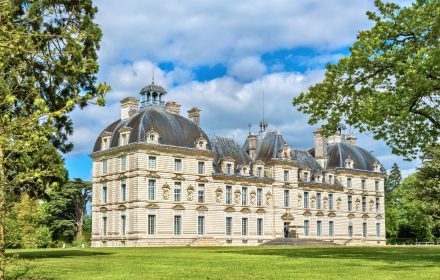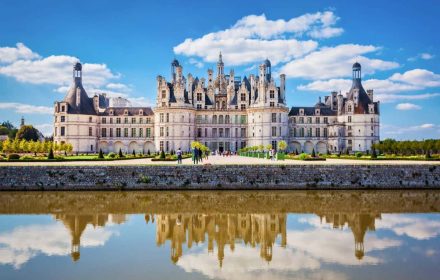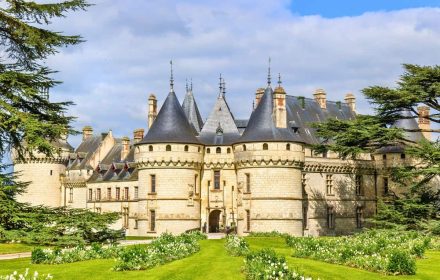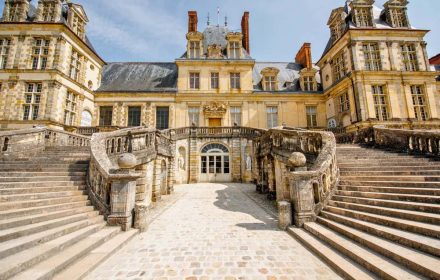This site uses affiliate links, meaning that if you make a purchase through our links, we may earn an affiliate commission.
Château de Chenonceau is one of the most enchanting castles in the Loire Valley, known for its elegant arches stretching across the River Cher and its rich tapestry of history, art, and gardens.
If you’re wondering what to see at Château de Chenonceau, this guide will walk you through the must-visit highlights and hidden gems that bring this extraordinary place to life.
From its iconic Grand Gallery to the beautiful gardens designed by powerful women of history, here’s everything you need to make your visit unforgettable, plus useful tips to help you plan the perfect day.
- 1. Brief History of Château de Chenonceau
- 2. What to See at Château de Chenonceau
-
- 2.1. The Architecture of Château de Chenonceau
- 2.2. The Chapel
- 2.3. Diane de Poitiers’ Bedroom
- 2.4. The Green Study
- 2.5. The Gallery
- 2.6. The Kitchens
- 2.7. François I’s Drawing Room
- 2.8. Louis XIV’s Drawing Room
- 2.9. The Five Queens' Bedroom
- 2.10. Catherine de’ Medici’s Bedroom
- 2.11. César of Vendôme’s Bedroom
- 2.12. Gabrielle d’Estrées’ Bedroom
- 2.13. The Domes Building
- 2.14. Gardens
- 3. Practical Tips for Visiting Château de Chenonceau
Brief History of Château de Chenonceau
Château de Chenonceau has a rich history, shaped by the hands of many women over the centuries.
The castle was originally built between 1514 and 1522 by Katherine Briconnet, the wife of Charles de Marques. This early version of the château was a classic Renaissance structure, set against the backdrop of the River Cher.
However, it was Diane de Poitiers, the mistress of King Henry II, who played a key role in shaping the castle’s future. In 1556, Diane took over the château and made significant changes, including the addition of stunning gardens that are still celebrated today.
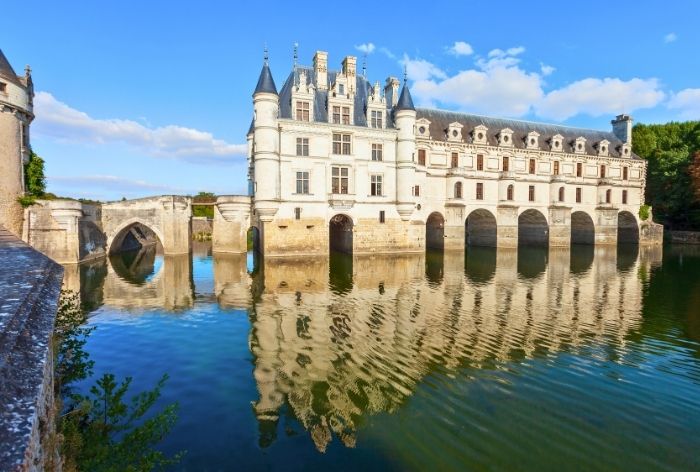
Château de Chenonceau
But the most famous transformation came when Catherine de Medici, the widow of Henry II, took control of the château after Diane was forced to leave in 1559.
Catherine added the iconic Grand Gallery, which stretches elegantly across the bridge that spans the River Cher. This addition made the château even more grand and was a defining feature of its architecture.
The château’s history was also marked by its survival during the French Revolution. Despite the widespread destruction of royal properties, Château de Chenonceau was spared, likely due to its association with the influential women who had once ruled over it.
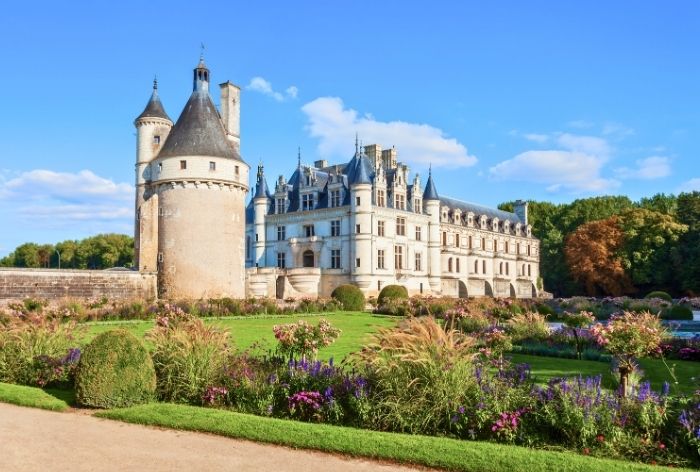
Château de Chenonceau
In the 20th century, the château found itself at the heart of World War II. Due to its location on the border between the German-occupied and free zones of France, it became a vital crossing point for the French Resistance.
The Grand Gallery was used as a secret passageway to move people safely between zones, cementing the château’s place in history as a symbol of resilience and courage.
What to See at Château de Chenonceau
The Architecture of Château de Chenonceau
One of Château de Chenonceau’s most unique features is its architecture. Built in the early 1500s, the château perfectly blends late Gothic and early Renaissance styles.
You’ll notice pointed arches and stone carvings from the Gothic tradition, as well as more open spaces, big windows, and decorative details that feel lighter and more elegant, which came with the Renaissance.
The original part of the château was built directly on the riverbank. Later, Catherine de Medici expanded the castle by adding the famous Grand Gallery.
This long hall stretches across the River Cher like a bridge and is lined with tall windows that flood the space with light. From the outside, it almost looks like the château is floating on water, which is part of what makes it so breathtaking.
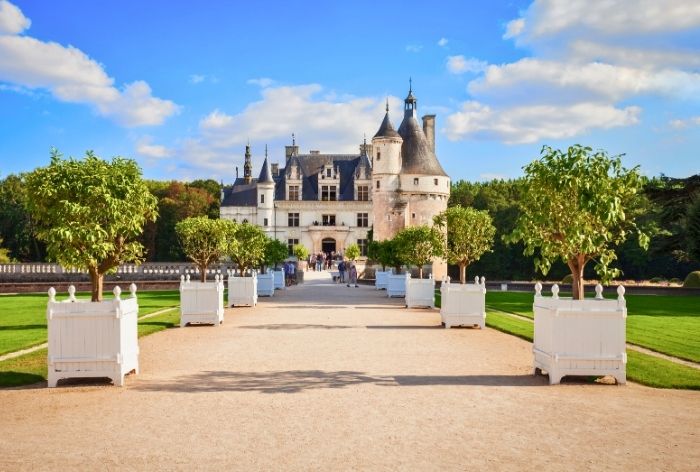
Château de Chenonceau
The Chapel
The Chapel at Château de Chenonceau was built in the early 16th century, during the time of Katherine Briçonnet, who oversaw much of the original construction. It was designed in a late Gothic style, with beautiful ribbed vaults and tall stained glass windows that fill the small space with natural light.
During the French Revolution, the chapel was at risk of being destroyed, but Madame Dupin, who owned the château at the time, managed to save it by covering the religious symbols and protecting it from damage. The stained glass windows that you can see today are not original; they were replaced after World War II, since the originals were destroyed during the bombings.
The chapel is simple but elegant, with a small altar and delicate stone carvings. One notable detail is the balcony above the entrance, which allowed the château’s residents to attend Mass privately, without being seen by the public.
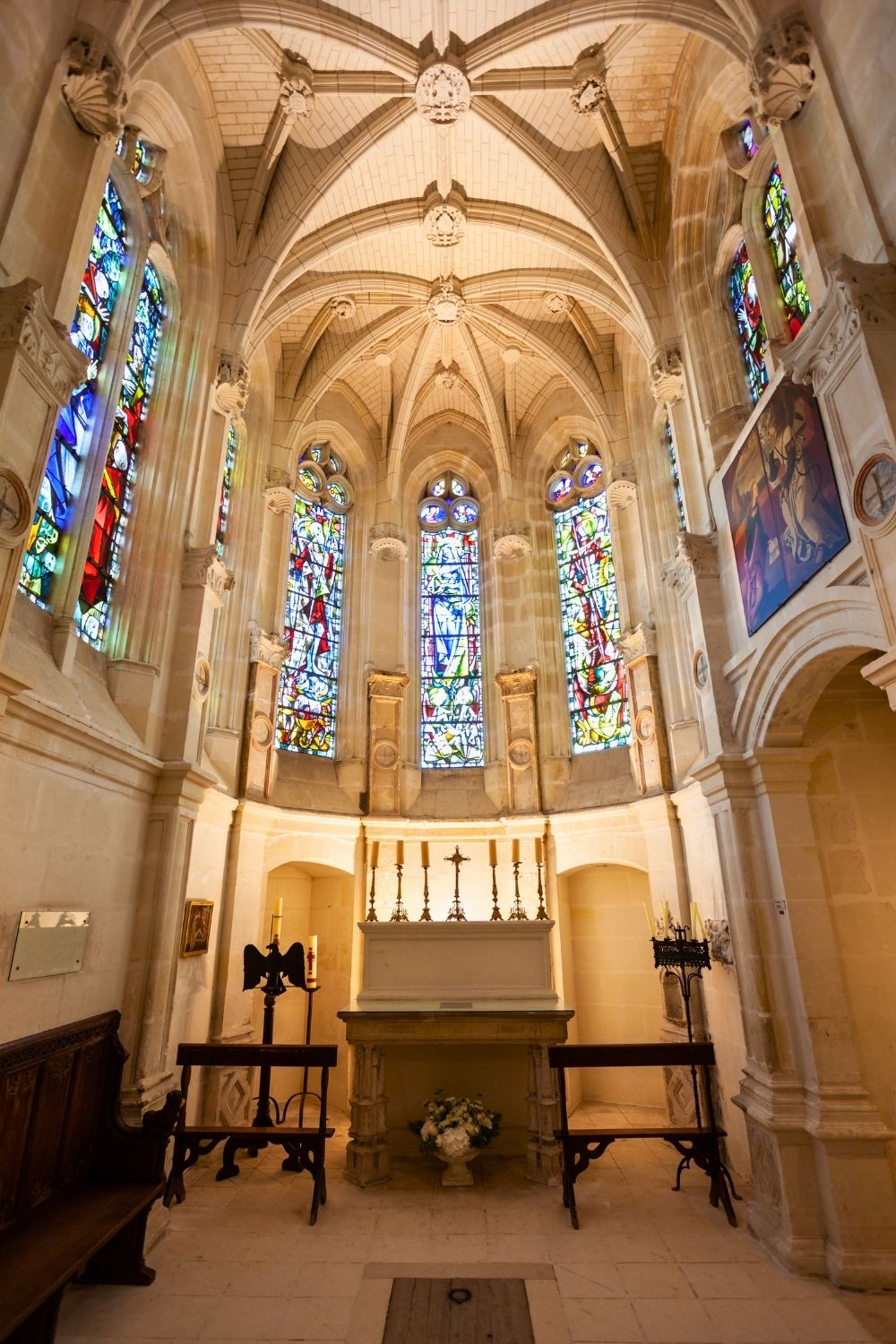
The Chapel / What to See at Château de Chenonceau
Diane de Poitiers’ Bedroom
Diane de Poitiers’ bedroom at Château de Chenonceau is full of luxury and hidden messages.
The centerpiece of the room is a massive four-poster bed, surrounded by beautiful Flemish tapestries that show scenes like the Triumph of Strength and the Triumph of Charity. These tapestries weren’t just for looks — they helped keep the room warm during the cold seasons.
One of the most interesting details is the fireplace, which was created by the sculptor Jean Goujon. If you look closely, you’ll notice the initials H and C (for Henry II and Catherine de Medici) cleverly twisted together to form a D, a quiet nod to Diane. Above the fireplace, there’s a portrait of Catherine de Medici — placed there later when she took the château from Diane after King Henry’s death.
Around the room, you’ll also spot a beautiful leather armchair from Spain and a painting of the Madonna and Child by Murillo.
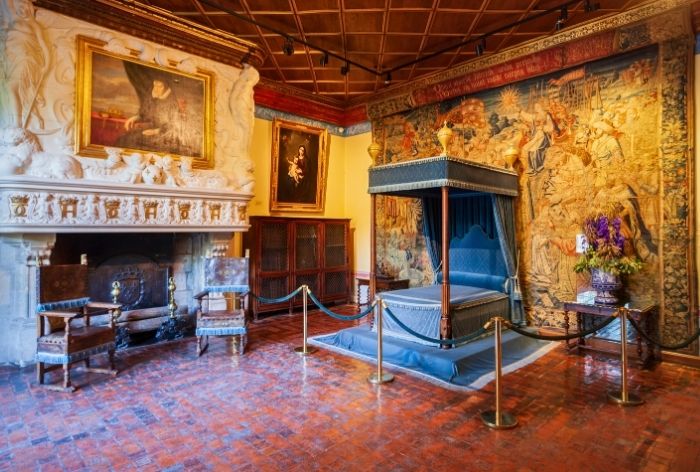
Diane de Poitiers’ Bedroom / What to See at Château de Chenonceau
The Green Study
The Green Study was Catherine de’ Medici’s personal office and one of her favorite rooms in the château.
Green was her favorite color, and the room is filled with rich green fabrics and tapestries that give it a calm but powerful atmosphere. This is where she handled state affairs after the death of her husband, King Henry II, when she ruled France as regent for her sons.
The ceiling is one of the most striking features — it’s decorated with her own initials, cleverly intertwined with those of Henry II, as a symbol of their royal connection. Around the room, you’ll find a fine collection of 16th-century paintings, chosen to reflect both her status and her taste for art.
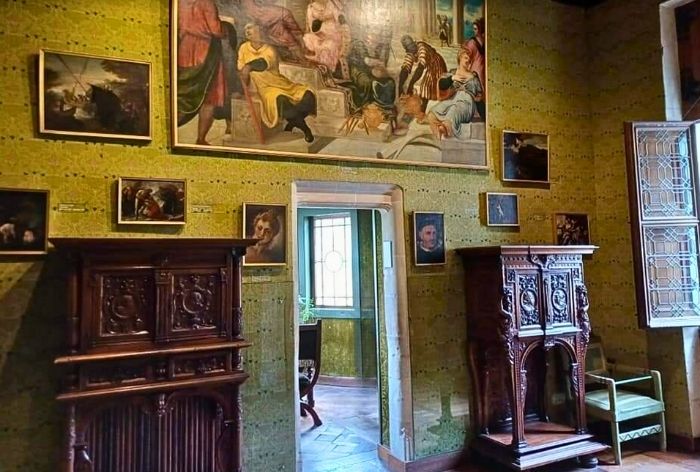
The Green Room / What to See at Château de Chenonceau
The Gallery
The Gallery is the most famous part of Château de Chenonceau. It stretches right across the River Cher, with 18 tall windows that fill the space with light and offer beautiful views of the water below.
The gallery is about 60 meters long and 6 meters wide, making it feel more like a grand ballroom than a hallway.
Catherine de’ Medici had the gallery built in 1576, turning what had been just a bridge into a magnificent two-story structure. The floor is covered in black-and-white marble tiles, and the vaulted ceiling gives the room a sense of elegance and openness.
During World War I, the gallery was used as a hospital for wounded soldiers, and during World War II, it became an escape route between Nazi-occupied and Free France because the river marked the border.
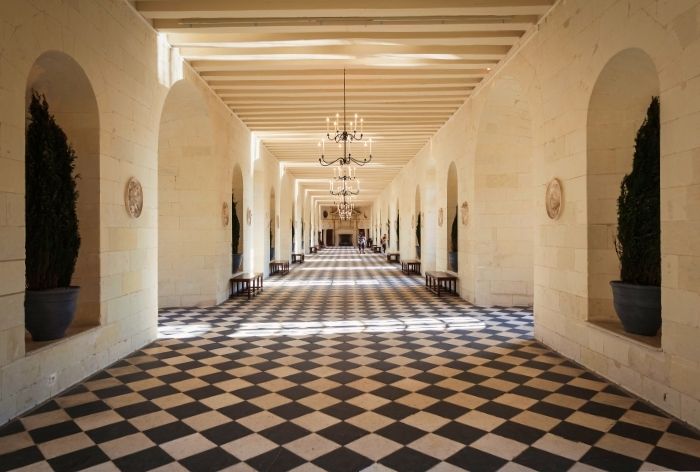
The Gallery / What to See at Château de Chenonceau
The Kitchens
The kitchens at Château de Chenonceau are tucked into the stone foundations that sit directly on the River Cher. They were built into the original piers of the bridge, making them some of the most unusual and practical parts of the château.
Thanks to their location right by the water, fresh fish, game, and other supplies could be delivered straight to the kitchens by boat.
Inside, you can still see the old stone ovens, massive fireplaces used for roasting meat, and heavy iron pots and pans hanging from the walls. There’s even a butchery, a pantry, and a bread oven — everything needed to prepare grand feasts for the château’s noble residents and their guests.
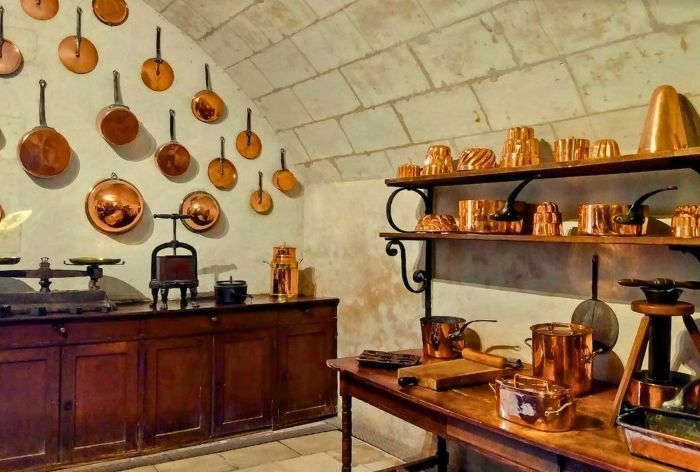
The Kitchens / What to See at Château de Chenonceau
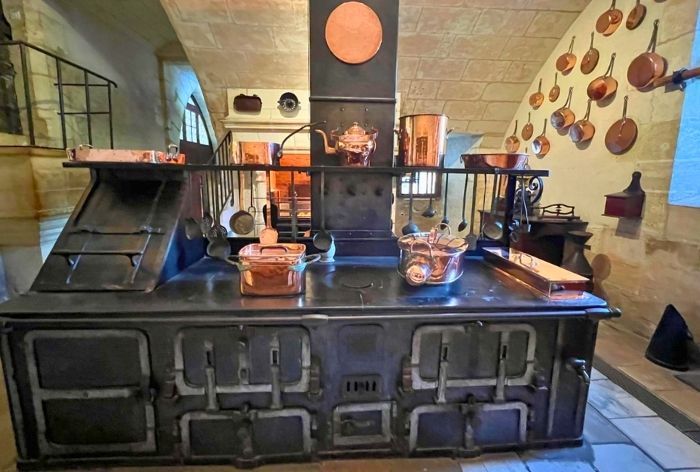
The Kitchens / What to See at Château de Chenonceau
François I’s Drawing Room
François I’s Drawing Room at Château de Chenonceau is one of the grandest spaces in the château. Even though François I himself didn’t live here long, the room is named after him because of the important collection of Renaissance art it holds.
The walls are covered with beautiful tapestries from the 16th century, and the room is filled with paintings by famous artists like Van Dyck, Poussin, and Tintoretto.
One highlight of the room is a large portrait of Diane de Poitiers, the famous mistress of King Henry II, reminding visitors of her lasting connection to the château.
Another striking feature of the room is its large stone fireplace, richly decorated with carvings from the Renaissance period. You’ll also notice the dark wooden ceiling, a typical style from François I’s time, showing off the skilled craftsmanship of the era.
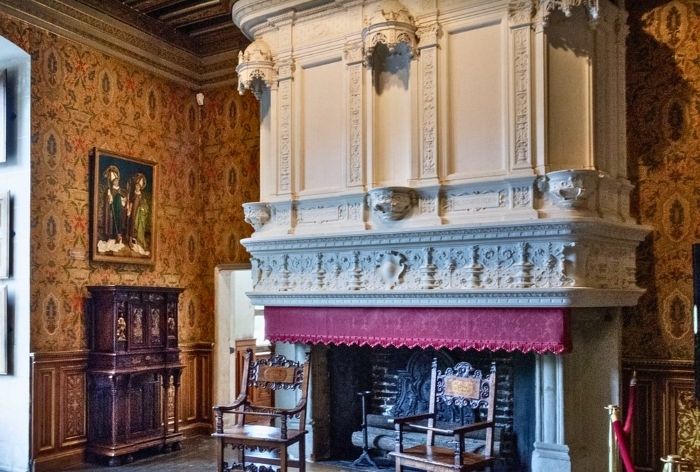
François I’s Drawing Room / What to See at Château de Chenonceau
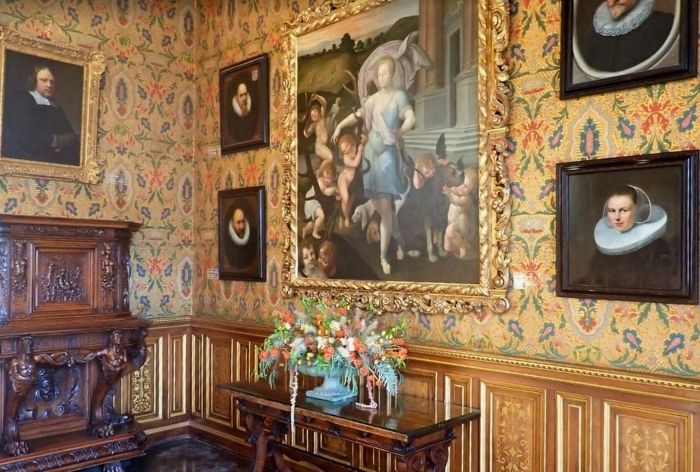
François I’s Drawing Room / What to See at Château de Chenonceau
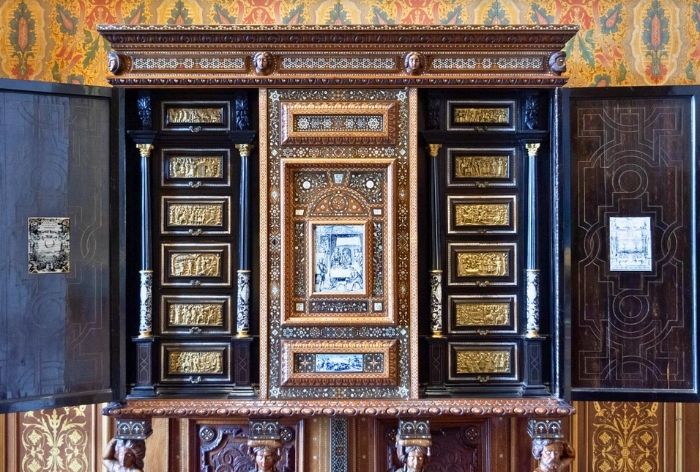
François I’s Drawing Room / What to See at Château de Chenonceau
Louis XIV’s Drawing Room
Louis XIV’s Drawing Room at Château de Chenonceau is a symbol of the grandeur and luxury of the Sun King’s reign.
The room was designed to reflect his power and taste, with richly decorated walls and elegant furnishings. It features beautiful tapestries, many of which were created to celebrate the king’s military victories and his rule over France.
One of the standout features of this room is the large portrait of Louis XIV himself, which hangs prominently on one wall. The painting captures the king’s imposing presence and serves as a reminder of the immense influence he held during his reign.
The room’s high ceilings, adorned with gold leaf and intricate molding, further emphasize the opulence of the era.
The furniture in the room, especially the chairs and tables, is also incredibly detailed, showcasing the fine craftsmanship of the period.
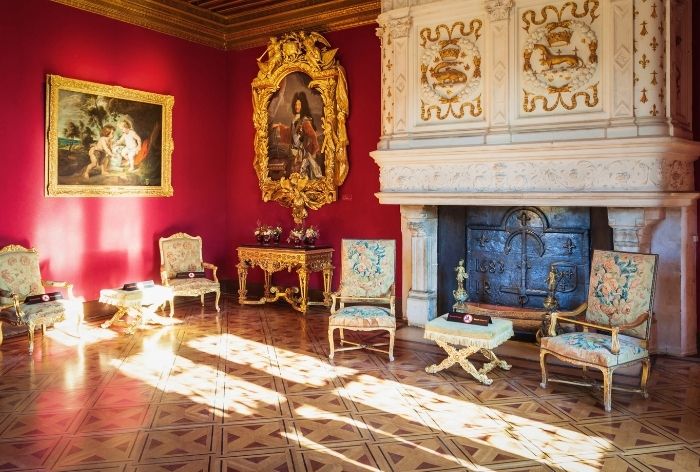
Louis XIV’s Drawing Room / What to See at Château de Chenonceau
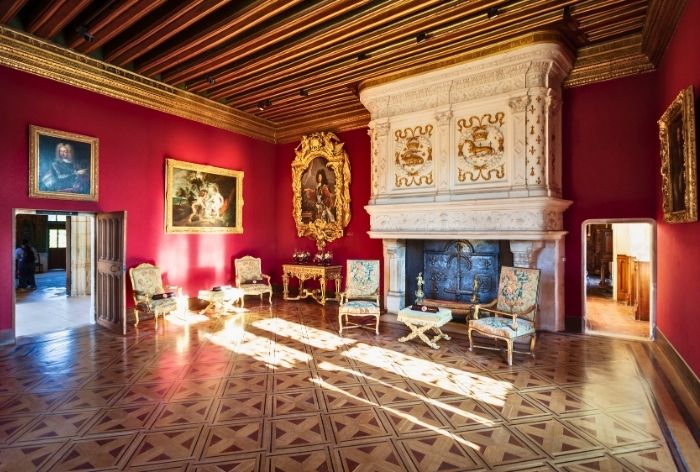
Louis XIV’s Drawing Room / What to See at Château de Chenonceau
The Five Queens' Bedroom
The Five Queens’ Bedroom at Château de Chenonceau gets its name because five different queens of France are said to have slept here throughout the history of the château.
These queens include Catherine de’ Medici, Louise of Lorraine, Marie de’ Medici, Henrietta of England, and Marie Antoinette. Each queen stayed at the château either as part of their royal duties or during times of personal significance, and their presence in the room is part of the rich history of the château.
The room itself is beautifully decorated, with tapestries that add a touch of elegance and a large, carved wooden bed. It’s not just a royal bedroom; it’s a room that connects these important women to the history of France.
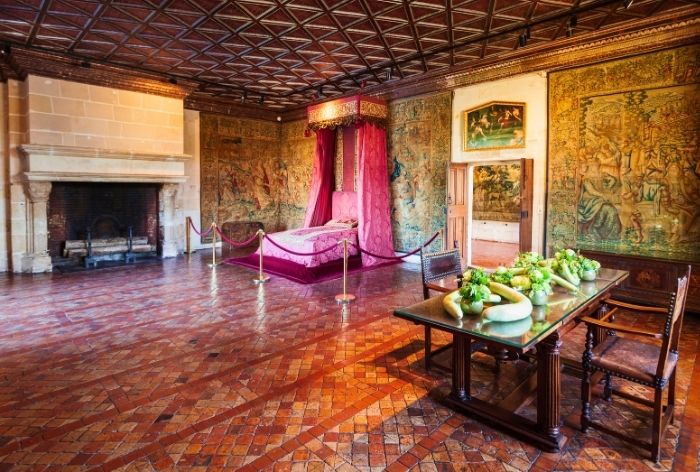
Five Queens’ Bedroom / What to See at Château de Chenonceau
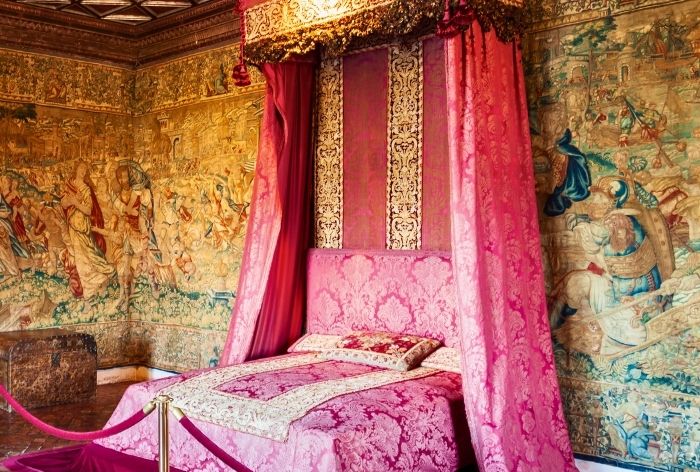
Five Queens’ Bedroom / What to See at Château de Chenonceau
Catherine de’ Medici’s Bedroom
Catherine de’ Medici’s bedroom at Château de Chenonceau is richly decorated and feels very much like the room of a powerful queen.
The walls are covered with dark green and gold tapestries from the 16th century, showing scenes of hunting and mythology, which were common symbols of power and leadership at the time.
The room holds a large carved oak bed, typical of royal bedrooms during the Renaissance.
The ceiling in her bedroom is an important detail — it’s made of finely painted wood, showing the craftsmanship of the period. Around the room, you’ll also find portraits of Catherine’s children, including future kings like Francis II, Charles IX, and Henry III. These paintings remind visitors of Catherine’s strong role as the mother of French royalty.
Other highlights in her bedroom include a marble fireplace, detailed wood paneling, and furniture that shows Catherine’s love of art and luxury.
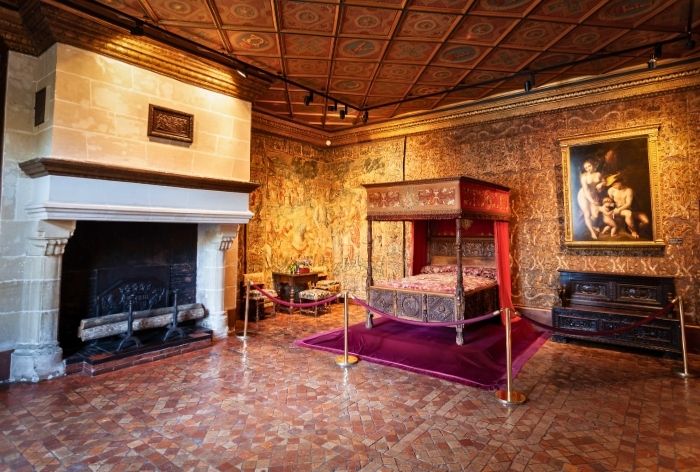
Catherine de’ Medici’s Bedroom / What to See at Château de Chenonceau
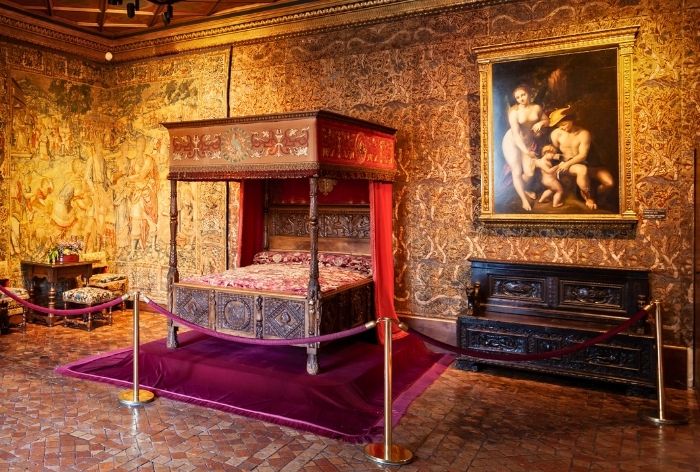
Catherine de’ Medici’s Bedroom / What to See at Château de Chenonceau
César of Vendôme’s Bedroom
César of Vendôme’s bedroom is one of the more masculine and richly decorated rooms in the château.
César was the illegitimate son of King Henry IV and Gabrielle d’Estrées, and he later married Françoise de Lorraine, tying him to the family that owned Chenonceau.
Though he never ruled France, César held powerful titles and was part of the royal court, so his bedroom reflects status and wealth.
The room features heavy wood paneling, a large carved bed, and rich fabrics in deep colors like red and gold. The dark tones and classical style give it a noble, almost military feel. On the walls, you’ll find portraits and tapestries that highlight his family’s importance and royal connections.
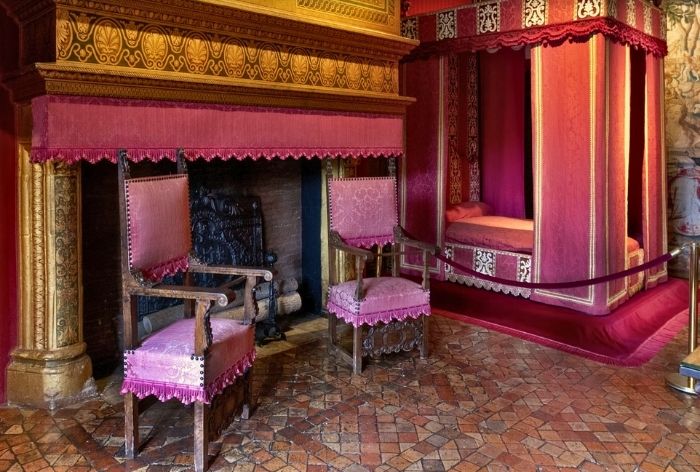
César of Vendôme’s Bedroom / What to See at Chateau de Chenonceau
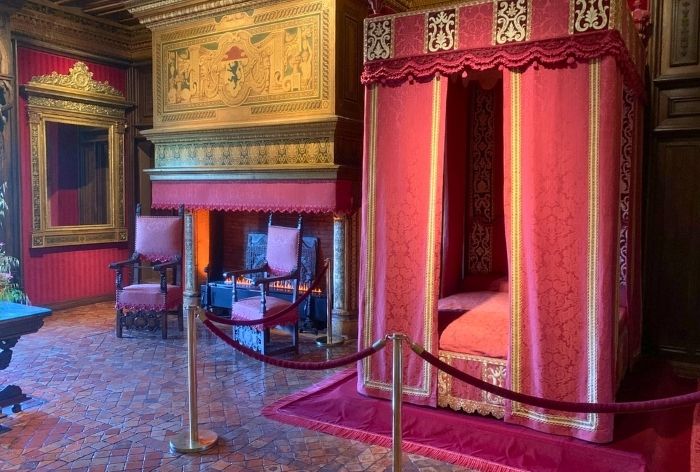
César of Vendôme’s Bedroom / What to See at Chateau de Chenonceau
Gabrielle d’Estrées’ Bedroom
This room is named after Gabrielle d’Estrées, the mistress of King Henry IV and mother of César de Vendôme..
Gabrielle never actually lived at Chenonceau, but her connection to the royal family and her influence at court earned her a place here in name.
The room has a warm, lived-in feel, with wooden beams on the ceiling and a large stone fireplace. The bed, covered in rich fabrics, sits beneath a canopy, and the walls are decorated with fine 16th- and 17th-century tapestries. One set, called the “Months of Lucas,” shows daily life in different seasons — scenes like sheep shearing or falconry, all woven in soft, faded tones.
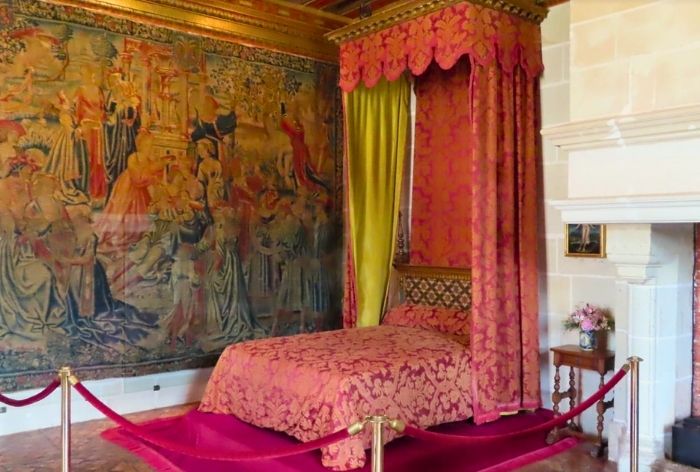
Gabrielle d’Estrées’ Bedroom / What to See at Château de Chenonceau
The Domes Building
Just outside the main château, is the Domes Building with a row of stone domes lining its roof.
It was commissioned by Catherine de’ Medici and designed in a style often called “Imperial”—simple, strong, and built for purpose rather than beauty. It was used to support the daily life of the estate — housing stables, storage, and staff quarters.
One room is the Queen’s Apothecary, where herbal remedies and potions were once prepared, reflecting Catherine’s deep interest in science and medicine.
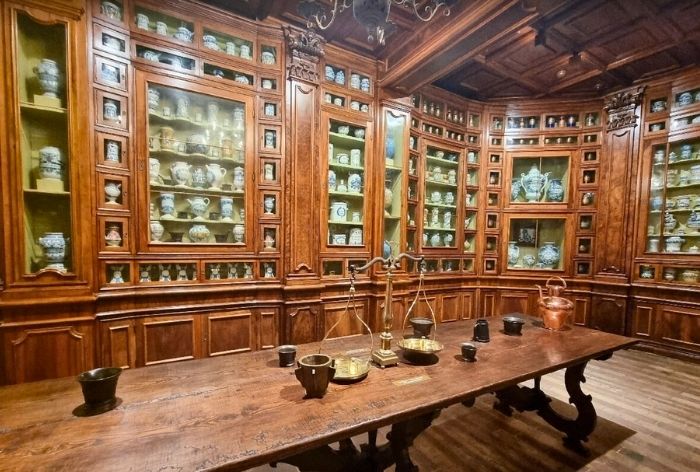
Queen’s Apothecary / What to See at Château de Chenonceau
Another is the Cave des Dômes, the château’s wine cellar, which once stored wine for the household and now highlights the region’s long winemaking tradition.
Gardens
- Diane’s Garden
Diane de Poitiers’ garden is the oldest at Château de Chenonceau and was designed when she lived there in the 16th century. It’s set just beside the river, framed by a stone terrace to protect it from flooding, and laid out in a perfectly balanced French style with neat flower beds, low box hedges
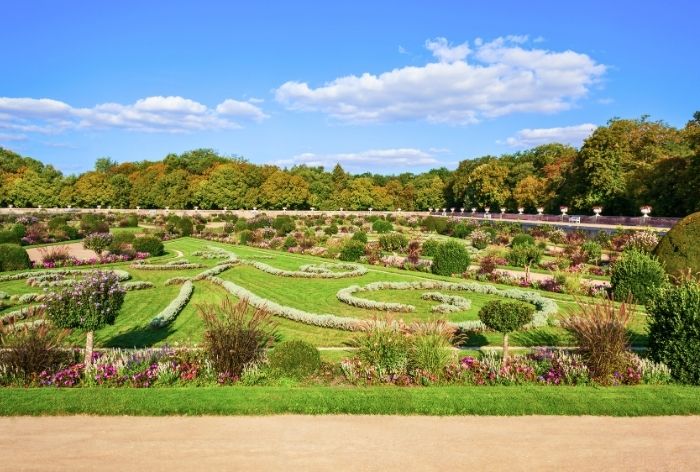
Diane’s Garden / What to See at Château de Chenonceau
- Catherine’s Garden
Catherine de’ Medici’s garden feels calm and refined, with five tidy lawns arranged around a round pond and bordered by low box hedges. A stone wall lined with climbing roses overlooks the moat, adding a soft, romantic touch. Lavender and rose bushes line the paths, filling the air with fragrance, and from the far end, you can see the Green Garden and Orangery—both designed by Bernard Palissy to reflect Catherine’s elegant and thoughtful style.
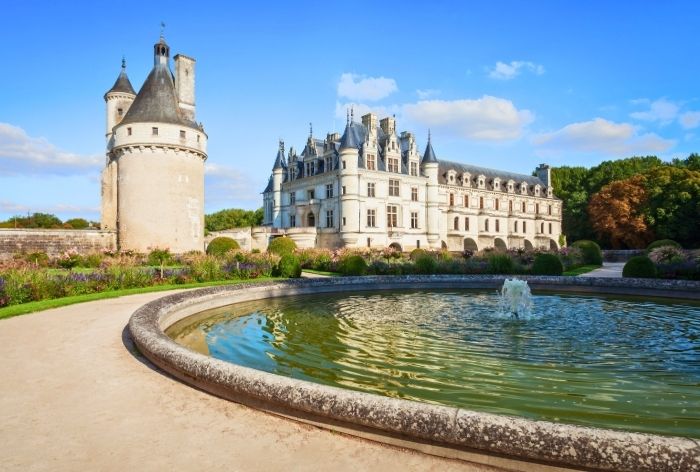
Catherine’s Garden / What to See at Château de Chenonceau
- Green Garden
This tree-filled garden offers cool shade from tall plane trees and sequoias. It features the Hortulus, where local plants and grape varieties are grown. It once housed Catherine de’ Medici’s aviary and animals. - Russell Page Garden
A modern garden inspired by landscape designer Russell Page, it follows an English style and includes sculptures by François-Xavier Lalanne. The layout blends art, plants, and open space. - Vegetable and Flower Garden
Divided into twelve square plots, this garden contains over 100 varieties of cut flowers, 400 rose bushes, vegetables, and two historic greenhouses. Donkeys and birds roam freely nearby. - The Maze
Made of 2,000 yew trees, the maze includes classical statues of mythological figures and a raised viewing platform in the center. It was designed for both fun and artistic flair.
Practical Tips for Visiting Château de Chenonceau
Getting to Château de Chenonceau
Château de Chenonceau sits right on the banks of the Cher River in the Loire Valley. It’s about 2 hours by car from Paris (roughly 214 km) and just 34 km from the city of Tours.
If you’re coming by car from Paris, the drive is straightforward — just take the A10 motorway toward Blois or Amboise.
By train, the fastest option is the TGV from Paris Montparnasse to Saint-Pierre-des-Corps, which takes about an hour. From there, hop on a local TER train to the Chenonceaux station. Once you arrive, it’s only a five-minute walk to the château.
There’s plenty of free parking on site for cars, motorcycles, and campers. Tour buses have their own parking area too, and there are lockers available if you need to store bags during your visit.
Tickets and Opening Times
Château de Chenonceau is open every day of the year, with varying hours depending on the season. For the most up-to-date information on opening times and ticket prices, including any special holiday hours, you can visit the official website here.
Where to Eat at Château de Chaumont-sur-Loire
Château de Chenonceau offers a few dining options, whether you’re in the mood for a quick bite or a more leisurely meal.
- The Snack
Located in the Bâtiment des Dômes, the château’s “fast food” spot is open daily from 10:00 AM to 5:30 PM. - The Crêperie
Near the ticket office and car park, the crêperie serves light meals, snacks, drinks, and delicious crêpes. Open daily from 10:00 AM to 4:30 PM. - L’Orangerie
Originally designed to shelter citrus trees in winter, L’Orangerie now serves as a charming restaurant and tea room, located opposite the Green Garden. - The Cave des Dômes
For wine lovers, the historic Cave des Dômes is a must-visit. Open daily from 10:30 AM to 1:00 PM and then again from 1:30 PM to 5:30 PM, it offers wine tastings in a stunning 16th-century cellar.
How Much Time Is Needed
To fully enjoy everything Château de Chenonceau has to offer, plan on spending around 3 to 4 hours. This will give you enough time to explore the château’s impressive rooms and galleries, take a leisurely stroll through the beautiful gardens, and maybe even enjoy a meal at one of the on-site restaurants.
Here Are Some More Ideas of Places to Visit in France:
What to See at Château de Villandry (13 Things You Can’t Miss + Practical Tips)
How to Visit Fontainebleau on a Day Trip from Paris (13 Best Things You Can’t Miss)
13 Tips for First Visit to Rouen to Help You Explore the City
DIY Walking Tour of Rouen (17 Best Stops, Map and Tips)
What to See at Château de Chaumont-sur-Loire (12 Things You Can’t Miss + Useful Tips)
What to See at Château d’Amboise (10 Things You Can’t Miss + Useful Tips for Your Visit)
What to See at Château d’Azay-le-Rideau (12 Things You Can’t Miss + Practical Tips for Your Visit)
How to Spend 6 Days in the Loire Valley (Detailed Itinerary + Practical Travel Tips)
7 Must-See Châteaux in the Loire Valley for First-Time Visitors (What to See + Practical Tips)
Did You Find It Useful? Why Not Save What to See at Château de Chenonceau to Pinterest!


Now, It Is Your Turn, I Would Like to Hear Back from You!
Are you planning your trip to France?
Please let me know! Drop me a quick comment right below!
Click on any of the images below to get inspired and to help you with the planning process for your trip to France!
